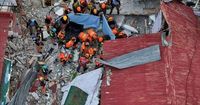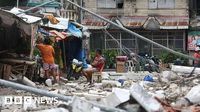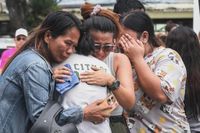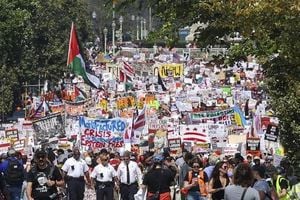As the clock struck 9:59 p.m. on Tuesday, September 30, 2025, a powerful magnitude-6.9 earthquake rattled the central Philippines, leaving a trail of devastation across Cebu province and its neighboring islands. The tremor, which struck at a shallow depth of around 10 kilometers (6.2 miles), had its epicenter just 12 miles northeast of Bogo City—a coastal community of about 90,000 that would soon find itself at the heart of a national tragedy.
By Wednesday afternoon, the confirmed death toll had risen to at least 69, with more than 140 people injured and hospitals near the epicenter struggling to cope with the influx of casualties, according to local authorities cited by Associated Press and Al Jazeera. The numbers, officials warned, could climb as rescue crews continued to work through the wreckage of collapsed homes, churches, and public buildings. The Philippine Institute of Volcanology and Seismology (Phivolcs) reported nearly 800 aftershocks by the following day, including one that registered a significant magnitude of 6.
Rescue efforts were fast and frantic, yet fraught with peril. Backhoes and sniffer dogs combed through ruined neighborhoods in Bogo and the outlying towns of Medellin, Tabuelan, and San Remigio, where landslides and falling debris had trapped residents. Sporadic rain, damaged bridges, and blocked roads slowed the search for survivors. "We’re still in the golden hour of our search and rescue," Office of Civil Defense deputy administrator Bernardo Rafaelito Alejandro IV explained in a news briefing, as quoted by Associated Press. "There are still many reports of people who were pinned or hit by debris."
The quake’s timing—late at night—meant many people were at home or asleep when disaster struck. In San Remigio, the roof of a sports complex collapsed during a basketball game, killing seven people, including members of the coast guard and the Bureau of Fire Protection, as reported by SunStar Cebu and Al Jazeera. Children as young as 12 were among the victims. The vice mayor of San Remigio, Alfie Reynes, described the grim situation: "It is raining heavily and there is no electricity, so we really need help, especially in the northern part because there’s a scarcity of water after supply lines were damaged by the earthquake," she told DZMM radio.
Images and videos circulating on social media and local news outlets showed the extent of the destruction: toppled homes, cracked highways, and centuries-old churches reduced to rubble. The 139-year-old Daanbantayan Church and the Saints Peter and Paul Parish on Bantayan Island, both treasured heritage sites, collapsed in the quake. "The current situation in Daanbantayan highlights the severe impact of the earthquake on heritage structures, which form part of Cebu’s rich cultural and spiritual identity," Cebu Governor Pam Baricuatro posted on Facebook.
Hospitals in Bogo City, already stretched thin, were quickly overwhelmed by the injured. Some patients had to be evacuated as aftershocks continued to shake the region. A representative for Senator Risa Hontiveros, chairperson of the Senate committee on health, told Al Jazeera that while the provincial hospital in Bogo had not suffered major structural damage, the staff was inundated. The Philippine Red Cross reported treating at least 60 people for injuries in three provinces and delivering much-needed water trucks to the hospital, as water supply lines had been severed.
The Philippine government moved quickly to respond. President Ferdinand Marcos Jr. pledged swift aid and deployed cabinet ministers to direct relief operations in the region. "We are assessing the damage, we are assessing the needs," Marcos said, as quoted by BBC. The Bureau of Fire Protection and the Philippine National Police were mobilized to assist with rescue and recovery, and the Department of Energy began work to restore power to affected areas. Parts of Cebu province were placed in a "state of calamity" to expedite the release of emergency funds and resources.
International support was immediate and heartfelt. The United States, India, Japan, Australia, and the European Union all expressed condolences and offered assistance. "We stand ready to support the Philippine government's response as friends, partners, allies," MaryKay Carlson, U.S. ambassador to the Philippines, posted on social media platform X. Indian Prime Minister Narendra Modi echoed the sentiment: "Deeply saddened to learn about the loss of lives and widespread damage caused by the earthquake in the Philippines. My thoughts and prayers are with the bereaved families. I wish the injured a speedy recovery. India stands in solidarity with the Philippines at this difficult time."
In the immediate aftermath, thousands of residents—traumatized by both the quake and a tropical storm that had battered the region just days earlier—chose to spend the night in open fields and parks, braving intermittent rain rather than risk returning to their damaged homes. The tropical storm, which struck on Friday, September 26, had already left at least 27 dead, mostly from drownings and falling trees, and forced mass evacuations. The back-to-back disasters underscored the vulnerability of the Philippines, which sits atop the volatile Pacific "Ring of Fire" and is pummeled by about 20 typhoons and storms each year.
Schools and government offices in affected cities and towns were closed as engineers assessed the safety of buildings. Local officials appealed for heavy equipment, food, water, and medical supplies. The provincial government urged residents to stay calm, move to open areas, and remain alert for further aftershocks. "Keep away from walls or structures that may collapse and stay alert for aftershocks," Governor Baricuatro advised in a Facebook post.
Despite the challenges, the spirit of cooperation and resilience was evident. The Philippine Red Cross, local government units, and national agencies worked together to distribute relief goods, clear debris, and provide medical care. The United Nations, through its Anticipatory Action Pilot Programme, continued efforts to empower local communities to better respond to such disasters. As UN resident coordinator Gustavo Gonzalez noted last year, "recognising and incorporating local ingenuity" is critical to developing "tailor-made solutions" for disaster response in the Philippines.
As rescue operations pressed on and aftershocks rumbled, the people of Cebu and the wider Visayas region faced a long road to recovery. But with support from both within and beyond the archipelago, hope persisted amid the rubble—a testament to the enduring strength of communities on the front lines of nature’s fury.






